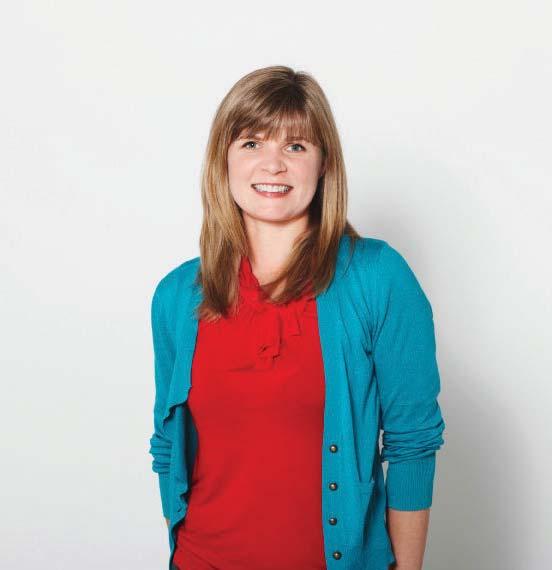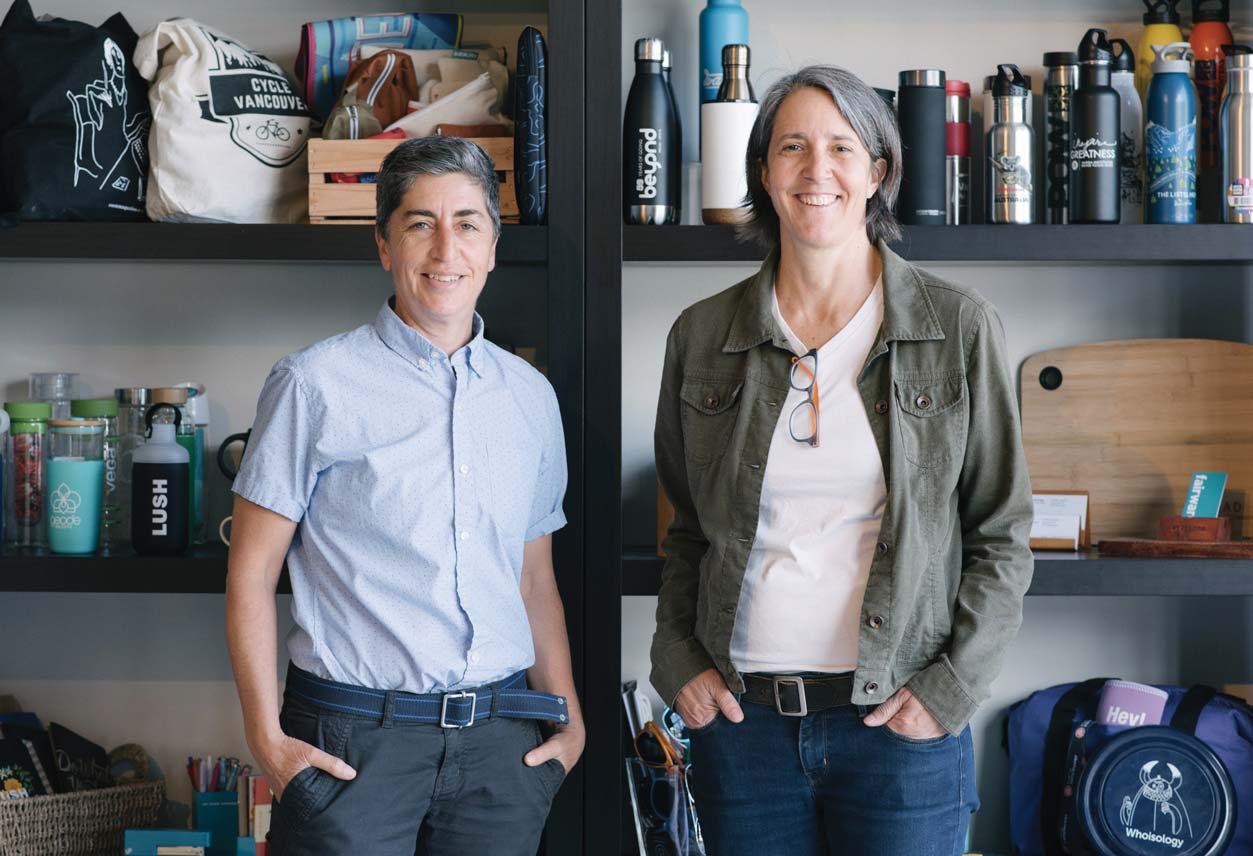
18 minute read
THE ENTREPRENEURS
from Women in Business Spring 2020
by GLACIER MEDIA DIGITAL LIMITED PARTNERSHIP dba BUSINESS IN VANCOUVER
How they built their businesses, in diverse fields ranging from aerospace to investment management 5 WOMEN TO WATCH THE ENTREPRENEURS:
DENE MOORE W omen are the fastest-growing segment of entrepreneurs in Canada, rapidly closing in on the business gender gap.
In British Columbia, about 38% of self-employed business owners in 2018 were women, according to the most recent Small Business Profile report by the Ministry of Jobs, Trade and Technology.
And the rate of growth is higher than it’s ever been. From 2013 to 2018, the number of female entrepreneurs grew 8.8%, according to the report.
Across Canada, women now account for 28% of all entrepreneurs. More than 17,400 women started businesses in Canada in 2018, according to the Business Development Bank of Canada (BDC).
“The entrepreneurial activity gender gap reached a record low in 2018,” says the BDC report A Nation of Entrepreneurs: The Changing Face of Canadian Entrepreneurship. Women in Business spoke to five B.C. entrepreneurs to watch about how they started their businesses and their top tips for others.
IF YOU’RE IN TECH, IT ALWAYS TAKES TWICE AS LONG AND COSTS ALMOST TWICE AS MUCH AS YOU ORIGINALLY THOUGHT j Catherine Dahl CEO, Beanworks Solutions
CATHERINE DAHL CEO, BEANWORKS SOLUTIONS INC.
The company: Beanworks Solutions provides an automated accounts payable platform for mid-market companies.
The aha moment: “I really believed in the product,” says CEO Catherine Dahl, who had handled a lot of accounts for various businesses over the years.
“Pushing paper around and making sure an invoice made it through the proper authority matrix is not something the human mind should waste its time on.”
By automating the data entry and processing of accounts payable, “you free up brain power in an organization to do much more interesting work, and much more important work for the organization.” Challenges: Dahl joined a previous version of the company in 2009, becoming the chief operating officer before that company stalled in the face of investment issues. The customers were happy with the platform, Dahl says, so she decided to pursue the plan as CEO of her own company.
It wasn’t easy. Beanworks immediately had customers who wanted the product up and running even while the team concurrently built a better platform. And in those early years, financing was a struggle, she says.
Beanworks qualified for several tech incubator programs in the early years, including Communitech’s Hyperdrive startup incubator. That involved Dahl moving to Waterloo, Ontario, for three months.
“I left my family here and moved to Waterloo in the middle of winter,” Dahl says. “I travelled back and forth, but that really helped us a lot because it opened up a lot of doors for me. I was able to get some traction on investment and got some training on how to do that.”
The woohoo moment: Beanworks has experienced 100% annual growth for the past two years, 85% the year prior to that.
“We’ve been going like crazy for the last two and a half years,” Dahl says.
After a significant period of investment in the early going, the company is seeing the kind of growth that puts her mind at ease.
“It takes a few years to build up momentum, but once you do, it’s like a lopsided cake. If you looked at it as a graph, each layer you get a big layer of customers that are coming along and just piling up atop one another. You get a leveraging effect over time. We’re starting to see that now,” Dahl says.
“We’ve made it. We’re going to be here for a while.” Top tips: “If you’re in tech, it always takes twice as long and costs almost twice as much as you originally thought,” Dahl says. “So plan and pay attention to your cash – that’s the most critical thing. If you don’t have money, you don’t survive.”
Plan three years ahead, she says.
STICK WITH YOUR VISION. IT MAKES A BIG DIFFERENCE BECAUSE THERE’S GOING TO BE A LOT OF PEOPLE GIVING ADVICE j Christine Sommers CEO and co-founder, ePact Network
CHRISTINE SOMMERS CEO AND CO-FOUNDER, EPACT NETWORK LTD. The company: ePact stands for emergencies: Prepare, Act, Connect, Thrive. The network provides secure, remotely accessible emergency contact and medical information and other key documents for organizations and families, and can send out automatic notifications in the event of emergencies. The aha moment: Co-founders Christine Sommers and Kirsten Koppang Telford were moved to act by a friend of theirs in Fukushima, Japan, who was separated from her daughters during the 2011 earthquake and tsunami. She had filled out the paper forms for their school but was out of town when disaster struck.
“Her kids sat on a school bus for 12 hours waiting for somebody to come pick them up,” Sommers says.
The pair of lifelong friends realized that most organizations in their own lives still used paper forms.
“We thought, ‘This is ridiculous,’” she says. Five years after their official launch, they have youth and family organizations throughout North America using the platform. In the U.S., business has been particularly brisk. “I hate to say it but in Canada, our general emergency is ‘Does a child have a peanut allergy?’ whereas in the States their big issue often is ‘Is there an active shooter on premises?’” Sommers says.
The system has emergency family contacts in 141 countries. In 2020 they expect to expand into the employer market. Challenges: It took three years to build and test the network. Following a pilot project in 2012 at three schools, they realized the need for a higher level of security due to the personal information being gathered. They went back and rebuilt the system in a more secure platform.
They also realized the need to modernize the type of information that is traditionally gathered – mom, dad, phone

numbers. Theirs is an emergency network with room for multiple parents and guardians with email, text and mobile alerts. The woohoo moment: “Our use cases, we would prefer they don’t happen but they do,” Sommers says.
The system is used by organizations such as the YMCA of Greater Vancouver, as well as several school districts and youth sports organizations, and is the mass notification system for Squamish-Lillooet Regional District and Pemberton. During the 2017 wildfires in B.C., the Red Cross used ePact for notifications.
The most common use, though, is when a child is injured or ill during an organized activity.
The growth far exceeded expectations right from the start, Sommers says. “We realized this is way bigger than we thought it was.”
In 2017, ePact Network was named the North Vancouver Chamber Business of the Year. Top tips: Trust your gut. Sommers recalls getting a lot of advice when they set out. “From the beginning we had a vision and at various points, I would say, got distracted by people saying ‘Try this’ or ‘Try that,’” she says. “Stick with your vision. It makes a big difference because there’s going to be a lot of people giving advice. Particularly when you get to raising money and talking to investors, it’s a barrage of ideas.”
The company: Trinity Aviation Group includes Trinity Aviation Services Ltd. and TAS Aerospace Ltd., and develops and manufactures carbon fibre aftermarket upgrades for the aerospace industry, primarily helicopters. The Surrey-based company also performs component overhauls and sells parts for helicopters. It does business all over the world, including in the U.S., Korea and South America.
The aha moment: Katrina Bartlett has been in the aviation industry for 17 years. Her husband, Warren Malmberg, previously owned the company HSS Helitech Support Services Ltd., which at one time had up to 80 employees. “It was a lot of work, and we just weren’t enjoying it,” Bartlett says.
In 2012, she launched Trinity Aviation, a smaller and more focused business with eight employees. She is the owner and president; Malmberg the general manager. Challenges: Funding. Trinity Aviation has invested heavily in research and development in its manufacturing. With any aspect of aviation, the certification process is rigorous and lengthy. Cash flow to front the R&D and then to wait for certification is a big challenge in such an R&D-heavy venture.
Bartlett, a member of the Tsartlip First Nation on Vancouver Island, was able to access some Indigenous business funding as well as some government funding, including some specifically for female entrepreneurs.
Her company’s research includes a redesign of the cabin floors for Bell medium-sized helicopters from aluminum to carbon fibre. The certification process has taken about four years, but the company has now received certification for a couple of its products, including its initial floorboards. With the concept now certified, Bartlett expects additional certification will be much quicker.
She expects to start manufacturing in the first quarter of 2020. “We’ll get it. It’s just a matter of time and funding,” she says. Another challenge was finding the right people to work with Trinity in such a specialized area. It ultimately hired someone from the U.S., who is working with the company on a work permit. The woohoo moment: “We’re not there yet,” Bartlett and Malmberg joke.
“But I can see the light at the end of the tunnel,” she says. “It’s a long road. In aviation it’s expensive and there are multiple hurdles to jump to get there, but we’re getting there. I see the light now. It’s been a lot of hard work and a lot of determination.” Top tips: “Just stick with it,” Katrina says. “It’s not an easy process growing a business. We’ve been established since 2012 and there’s always hurdles, and one of the biggest ones is financial. Just put your head down and keep with it is my advice.”
IT’S NOT AN EASY PROCESS GROWING A BUSINESS.… THERE’S ALWAYS HURDLES, AND ONE OF THE BIGGEST ONES IS FINANCIAL j Katrina Bartlett Owner and president, Trinity Aviation Group
plan your next executive retreat in the mountains





luxury lakeside accommodation unique meeting spaces award-winning spa personalized dining





1 888 755 6482 nitalakelodge.com/meetings sales@nitalakelodge.com 2131 Lake Placid Rd, Whistler, BC

WE HAVE POWER. IT’S ABOUT PAYING ATTENTION TO WHERE THAT POWER IS j Bonnie Foley-Wong Founding investor and director, Pique Fund, and CEO, Pique Ventures
The company: Pique Ventures is a boutique investment management firm launched by Bonnie Foley-Wong in 2012. The angel investor fund Pique Fund stemmed from that in 2014. While Foley-Wong relocated to Toronto in late 2019, the fund remains based in B.C. The aha moment: Foley-Wong had a number of investors who wanted to support businesses led by women but didn’t have either the time or the know-how to find them. “They didn’t know where to identify startups that they could invest in, let alone [how to] evaluate them. So I had undertaken a validation process to try and find fits,” she says.
At the same time, Foley-Wong was encountering women with business ideas who struggled to get the attention they needed. Pique Fund was born. Challenges: Female entrepreneurs have not always had a lot of capital support, Foley-Wong says.
“A lot of entrepreneurs I spoke with were telling me they were going to investor events, venture events, and they’d be walking into a meeting to pitch an investor and it was always all men. For me, I was going to these events and I would be one of a handful of women in a room of 50 men,” she says.
“I’ve grown up in finance and the male-dominated environment. To a certain extent, I’m used to it. But at the same time I was wondering, ‘Where are all the women?’” The woohoo moment: Her goal for Pique Fund was 75% of capital going to women. “As it turns out, the compelling opportunities were all women-founded,” she says. There are seven companies currently in the fund portfolio. All were brought to Pique by women.
On the investor side, there are currently 41 investors. Including Foley-Wong herself, 32 of them are women. Top tips: First, save up and be your own angel investor, she says.
“The more financial resources you have, the more you can be in a position of power to direct how things go. You’re a financial investor in your own business. If you have to seek financing, you’re coming to those conversations as a peer, as a partner, and you’re more likely to be able to control your destiny if you have that financial stake.”
Second, she urges entrepreneurs to recognize the power of their skills and experience.
“We have power. It’s about paying attention to where that power is,” she says. “Don’t go starting something else that has nothing to do with what you’ve been doing.”
I ALWAYS THOUGHT IT WAS GOING TO WORK. NOBODY ELSE DID, BUT I DID. HOW COULD IT NOT WORK? THAT’S WHAT KEPT ME GOING j Natacha Beim Founder and executive chair, CEFA Systems
The company: CEFA – Core Education and Fine Arts – franchises are private early-learning schools for children aged one to five. Natacha Beim incorporated CEFA in 1996 and opened the first school in 1998. There are now 30 schools across Canada and six more under construction.
The aha moment: Twenty-five years ago, Beim returned to Canada after teaching junior kindergarten in France.
“I was used to teaching children at a young age, rather than just babysitting,” she says. “I tried to find a place like that [here] … and I couldn’t find one, so I thought, ‘Well, I’ll just open my own. It can’t be that hard.’” She laughs.
Challenges: “It was really hard,” she says. “I knew nothing about marketing; I knew nothing about hiring or HR – I didn’t know anything. It was very frustrating at first because all I wanted to do was just be in the classroom and teach. That’s all I ever wanted to do, and now I was running a school and training teachers to be the teacher I wanted to be.”
One of the primary challenges was building the franchise model while being a mom.
“I had my kids, and I wanted them to have an amazing childhood with their mom. There were not enough hours in the day,” she says.
T he ot her ch a l lenge wa s f i n a nci a l. She got a small-business loan at the outset but after that she financed growth herself.
“When you build a franchise model, you have to service the franchise needs. You’re always incurring debt,” Beim says.
The woohoo moment: “I always thought it was going to work,” she says. “Nobody else did, but I did. How could it not work? That’s what kept me going.”

Still, it wasn’t until the 17th year that she thought to herself, “I made it.”
Before that, though, CEFA allowed her to spend her days with her two sons.
“I got to spend literally my children’s entire childhood with them, and when they started going to elementary school, I had the same schedule as them, the same holidays as them. It allowed me to be a mom as well as run a business.”
Her sons are now 20 and 18. Top tips: Be patient, Beim says. “I read that 80% of entrepreneurs give up when they’re almost there. Every time I was at my wits’ end … I thought, ‘Well, I must be almost there.’”
Second, get a mentor. “There are a lot of people who want to help, so reach out to someone who can answer some of your questions and make you feel a little better when you’re down,” she says. É
TIME TO RETHINK ASSUMPTIONS The current investment momentum around women could be the first step that will allow us to take a bigger step
CHRISTINE BERGERON
The other day I overheard someone say, “The best person to be right now is a woma n w ith a business idea. Money is looking for her.”
There’s some truth to that. In recent years, a lot of new and existing investment flows have gravitated to women. Whether it’s from female-focused venture funds, new funds led by women, government investment directed at female entrepreneurs or mentorship and education programs aimed at creating more room for women in business, the market is betting on women right now. Obviously, this is news we should celebrate.
Throughout my career in finance, as a venture capitalist, hedge fund professional, entrepreneur and banker, I have argued that we need to open up access to capital for female entrepreneurs, for more funding, more education and resources, more female investors making investment decisions. Why? Because women present their business opportunities very differently than men do. They also ask for less money, tend to take on less debt and can be more cautious with their growth. They tend to personalize business failures more than men will. They have fewer role models.
We also know how many businesses led by women receive equity financing and how many women are partners in investment firms. The numbers are low. And despite the apparent market momentum, they haven’t changed much in many years. That’s because markets are not out to empower anybody. They’re looking for good returns.
Generally, as we’ve tried to puzzle through the problem of how to get more women to the investment table, the problem is seen in two ways: as a problem of motivation and as a problem of money. If only we could persuade more women to somehow decide to become business leaders or investment bankers, we’d solve the problem. Or, if only more women had access to investment funds, there’d be more women in the system. The current financial trend toward women is really based on these two assumptions. Given all the recent momentum, all the roundtables, research and newfound focus for investment flows, one could be forgiven for believing the stats should look a lot different. So why don’t they?
One answer might be that we’re looking at the problem through the wrong lens. All the positives associated with more funding, more capital, more education, more resources and more female investors may not get us where we want to go. We should also be clear about why we believe it’s important to have more women at the table. I think it’s because the outcomes of investment are different when we increase diversity in investment decisions. What gets funded matters. If you want cost-effective green technology to combat climate change, for example, a ton of investment is needed. So different investment choices are required.
Maybe we need to change our systemic assumptions. The financial system is founded on assumptions about what matters and therefore what gets funded. While there are exceptions, generally the female-led startups getting money are the ones that fit a particular growth model – the one that maximizes profit and fits into the existing framework that governs how capital gets raised.
At the same time, we want the system to be more diverse, looking to increase the number of female investors. We’re using the same inputs expecting different outcomes. If we are simply adding women to the same investment lens, how diverse will the end results really be? Are we still trying to get more women into partner roles with venture firms but not changing how venture firms are run or the values that power them? Are we still trying to recruit more women to the sector while remaining focused on building unicorns with massive potential for returns and with equal capacity to create social problems along the way?
I deeply appreciate the value of having more women in control of more capital and the decisions over where to put it. I truly believe that how we allocate capital influences outcomes and our future. What kinds of companies, structures and outcomes we’re funding matters a lot.
Maybe all the recent momentum around women is the first step that will allow us to take the second step. But that next part is the most important. Our current investment framework has created the greatest uninterrupted period of prosperity in human history. It’s also driven us to the brink of a global crisis. And tinkering with representation won’t get us out of it. By rethinking our assumptions, we might create surprising solutions.
So more money for women matters: both more women receiving funding and more women making investment decisions. They are necessary to help drive a different lens. Though necessary, they are likely insufficient to effect larger, system-wide change. For that, we need to take the second step as well. É
Christine Bergeron is chief member services officer at Vancity credit union, chair of the Women’s Enterprise Centre and a board member for Aviso Wealth. She has spent over two decades working with entrepreneurs, financing innovative companies and building financial firms, all focused within the clean tech, sustainability and impact investing sectors.





